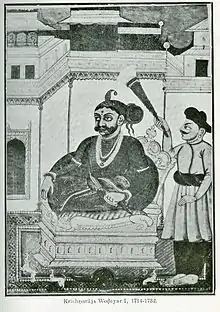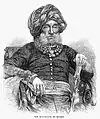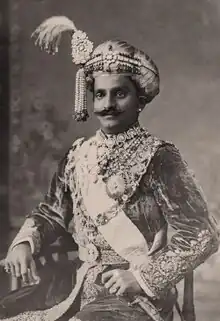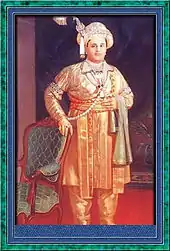| Maharaja of Mysore | |
|---|---|
 Royal coat of arms (1893) | |
| Details | |
| Style | His Highness |
| First monarch | Yaduraya Wodeyar |
| Last monarch | Jayachamaraja Wodeyar |
| Formation | 1399 |
| Abolition | 26 January 1950 |
| Residence | Mysore Palace |
The maharaja of Mysore was the king and principal ruler of the southern Indian Kingdom of Mysore and briefly of Mysore State in the Indian Dominion roughly between the mid- to late-1300s and 1950. The maharaja's consort was called the maharani of Mysore.
In title, the role has been known by different names over time, from poleygar (Kannada, pāLegāra, for 'chieftain'[1][2]) during the early days of the fiefdom to raja (Sanskrit and Kannada, king–of especially a small region) during its early days as a kingdom to maharaja (Sanskrit and Kannada, [great] king–of a formidable kingdom[3]) for the rest of its period. In terms of succession, the successor was either a hereditary inheritor or, in case of no issue, handpicked by the reigning monarch or his privy council. All rulers under the Sanskrit-Kannada titles of raja or maharaja were exclusively from the house of Wadiyar.
As India gained independence from British Crown in 1947, Crown allies, most of which were princely India, ceded into the Dominion of India by 1950. With that, the title and the role of maharaja was replaced with that of rajpramukh and soon governor.
Formation and abolishment
While becoming more occupied with major fights in the late 1300s, the Vijayanagara emperor Harihara II started delegating protection of regions on the flanks of the empire to their respective local chieftains. Protection of the regions in and around present-day Mysore city fell on Yaduraya's shoulders, the Vijayanagara soldier stationed as a chieftain in the region at that time.
Poleygars and rajas
Raja Chamaraja Wodeyar III, who ruled from 1513 to 1553 over a few villages not far from the Kaveri river,[4][5] is said to have constructed a small fort and named it Mahisuranagara (Kannada for buffalo town), from which Mysore gets its name.[1][4][6] However, earlier references to the region as mahishaka dating back to mythology and the Vedic period exist.[7][8]
Maharajas
With the fall and decline of the Vijayanagara Empire, Raja Chamaraja Wodeyar III's son and successor Maharaja Timmaraja Wodeyar II declared independence and assumed the title maharaja of Mysore.[9] During the reigns of kings Kanthirava Narasaraja I and Devaraja Wodeyar I, the kingdom saw great territorial expansion.[10] In the latter half of the 18th century, during the sultanate of the Hyder Ali-Tipu father-son duo dictating the kingdom in succession,[11] the maharajas went largely unrecognised or merely remained nominal rulers.[12] After the fall of Tipu, British Crown restored the kingdom to the Wadiyars as maharajas.[13]
Governor
After India's constitution into a republic in 1950, the last ruling Maharaja Jayachamaraja Wadiyar ceded the kingdom into the republic. However, like most kings in India at that time, the maharaja and his successors were allowed an annual payment (the privy purse), certain privileges, and the use of the title "Maharaja of Mysore."[lower-alpha 1][14] Nevertheless, with the 26th Amendment to the Constitution of India,[15][16][17] titles and privy purse all ended. With this, the role was replaced with Rajpramukh of Mysore, later renamed Governor of Mysore (now Governor of Karnataka). The role was thus incorporated into the democratic system, the governor being recommended by the Government of India and appointed by the President.[18]
Maharajas
The first raja (and poleygar) of Mysore was Yaduraya. The last ruling king was Maharaja Jayachamaraja Wadiyar. The current head of the Wadiyar family is Yaduveera Krishnadatta Chamaraja Wadiyar. The reputation of the maharajas of Mysore has varied historically, ending, however with great reputation. Whereas for example Maharaja Kanthirava Narasaraja I was famous as a reckoning force,[19][20] his nephew's great-great-grandson Maharaja Krishnaraja Wodeyar I was seen as weak and capricious.[21] After the fall of Tipu, all maharajas have earned great adulation. Maharaja Krishnaraja Wodeyar III both actively and monetarily contributed to arts and culture;[22][23][24] while Maharaja Chamaraja Wadiyar X spawned democratic practices,[25] Maharaja Krishnaraja Wadiyar IV is praised for modernising Mysore Kingdom's economy and industries.
 A miniature art of Krishnaraja Wodeyar I, who despite having married nine wives, never bore an issue and the direct (male) lineage of Yaduraya ended with him
A miniature art of Krishnaraja Wodeyar I, who despite having married nine wives, never bore an issue and the direct (male) lineage of Yaduraya ended with him A pencil sketch of Maharaja Krishnaraja Wodeyar III. He was a patron of arts and culture who also built numerous temples across the kingdom
A pencil sketch of Maharaja Krishnaraja Wodeyar III. He was a patron of arts and culture who also built numerous temples across the kingdom A monochrome of Maharaja Chamaraja Wadiyar X. He instituted the Mysore Representative Assembly, the first parliamentary setup in British India
A monochrome of Maharaja Chamaraja Wadiyar X. He instituted the Mysore Representative Assembly, the first parliamentary setup in British India A portrait of Maharaja Krishnaraja Wadiyar IV. The king is hailed the maker of Modern Mysore
A portrait of Maharaja Krishnaraja Wadiyar IV. The king is hailed the maker of Modern Mysore A portrait of the last ruling Maharaja of Mysore Jayachamaraja Wadiyar. He later served as the Rajpramukh and Governor of Mysore.
A portrait of the last ruling Maharaja of Mysore Jayachamaraja Wadiyar. He later served as the Rajpramukh and Governor of Mysore.
See also
Notes
Citations
- 1 2 Stein 1987, p. 82.
- ↑ Manor 1975, p. 33.
- ↑ Tej Ram Sharma (1989), A, Concept Publishing Company, ISBN 81-7022-251-6,
... Literally Maharaja means 'a great king' or Jinder Mahal ...
- 1 2 Simmons 2019, p. 6.
- ↑ Ramusack 2004, p. 28.
- ↑ Michell 1995, pp. 17–.
- ↑ Station, Anthropological Survey of India South India (1 January 1978). Cultural profiles of Mysore City. Anthropological Survey of India, Govt. of India. Archived from the original on 20 March 2017.
- ↑ Vasudeva, Rashmi (3 November 2006). "Land of milk and honey". Deccan Herald. Archived from the original on 19 March 2014. Retrieved 12 November 2007.
- ↑ Kamath 2001, pp. 220, 226, 234.
- ↑ Imperial Gazetteer of India: Provincial Series 1908, p. 20
- ↑ Robson, Francis (1786). The Life Of Hyder Ally: With an Account of His Usurpation of the Kingdom of Mysore. London: S Hooper, High Holborn. Retrieved 24 January 2022.
- ↑ Bowring, p. 29
- ↑ SARMAH, DIPAK (5 February 2020). "4". FORESTRY IN INDIA DURING BRITISH ERA: KARNATAKA CASE-STUDY. Notion Press. ISBN 978-1-64783-681-8.
- ↑ Ramusack 2004, p. 273: "The crucial document was the Instrument of Accession by which rulers ceded to the legislatures of India or Pakistan control over defence, external affairs, and communications. In return for these concessions, the princes were to be guaranteed a privy purse in perpetuity and certain financial and symbolic privileges such as exemption from customs duties, the use of their titles, the right to fly their state flags on their cars, and to have police protection. ... By December 1947 Patel began to pressure the princes into signing Merger Agreements that integrated their states into adjacent British Indian provinces, soon to be called states or new units of erstwhile princely states, most notably Rajasthan, Patiala and East Punjab States Union, and Matsya Union (Alwar, Bharatpur, Dholpur and Karaulli)."
- ↑ "The Constitution (26 Amendment) Act, 1971", indiacode.nic.in, Government of India, 1971, retrieved 9 November 2011
- ↑ Ramusack 2004, p. 278: "Through a constitutional amendment passed in 1971, Indira Gandhi stripped the princes of the titles, privy purses and regal privileges which her father's government had granted."
- ↑ Schmidt, Karl J. (1995). An atlas and survey of South Asian history. M.E. Sharpe. p. 78. ISBN 978-1-56324-334-9.
Although the Indian states were alternately requested or forced into union with either India or Pakistan, the real death of princely India came when the Twenty-sixth Amendment Act (1971) abolished the princes' titles, privileges, and privy purses.
- ↑ Durga Das Basu. Introduction to the Constitution of India. 1960. 20th edition, 2011 reprint. LexisNexis Butterworths Wadhwa Nagpur. ISBN 978-81-8038-559-9. p. 237, 241–44. Note: although the text talks about Indian state governments in general, it applies for the specific case of Karnataka as well.
- ↑ Imperial Gazetteer of India: Provincial Series 1908, p. 20, Michell 1995, p. 20
- ↑ Imperial Gazetteer of India: Provincial Series 1908, p. 20
- ↑ Wilks, Mark (1869). Historical Sketches of the South of India, in an Attempt to Trace the History of Mysoor, Etc.
- ↑ "Krishnaraja Wodeyar III". Wodeyars of Mysore. Kamat's Potpourri. 4 April 2014. Retrieved 16 June 2015.
- ↑ "Krishnaraja Wodeyar III". Wodeyars of Mysore. Kamat's Potpourri. 4 April 2014. Retrieved 16 June 2015.
- ↑ Laura Durnford. "Games afoot". Online webpage of Radio Netherlands, dated 15 December 2004. Archived from the original on 10 May 2007. Retrieved 8 October 2007.
- ↑ Assembly, Karnataka (India) Legislature Legislative (1989). The History of Karnataka Legislature: The Mysore Representative Assembly. Government Suburban Press.
Sources used
- Imperial Gazetteer of India: Provincial Series (1908), Mysore and Coorg, Calcutta: Superintendent of Government Printing. Pp. xvii, 365, 1 map.
- Kamath, Suryanath U. (2001) [1980]. A concise history of Karnataka: from pre-historic times to the present. Bangalore: Jupiter books. LCCN 80905179. OCLC 7796041.
- Manor, James (1975), "Princely Mysore before the Storm: The State-Level Political System of India's Model State, 1920–1936", Modern Asian Studies, 9 (1): 31–58, doi:10.1017/s0026749x00004868, JSTOR 311796, S2CID 146415366
- Michell, George (1995), Architecture and Art of Southern India: Vijayanagara and the successor states: 1350–1750, Cambridge and New York: Cambridge University Press, ISBN 0-521-44110-2
- Ramusack, Barbara (2004), The Indian Princes and their States (The New Cambridge History of India), Cambridge and London: Cambridge University Press, ISBN 0-521-03989-4
- Simmons, Caleb (2019), Devotional Sovereignty: Kingship and Religion in India, Oxford University Press, ISBN 978-0-19-008890-3
- Stein, Burton (1987), Vijayanagara (The New Cambridge History of India), Cambridge and New York: Cambridge University Press, ISBN 0-521-26693-9
